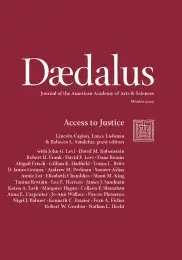Introduction
Emblazoned on the facade of the United States Supreme Court building are four simple words intended to embody the overriding principle of the U.S. legal system: EQUAL JUSTICE UNDER LAW. Yet after more than 225 years, the nation still has not developed the means to fulfill this principle.
There are many reasons for that failure, but perhaps foremost among them is that the legal system does not ensure that all individuals with a civil legal problem get access to and secure either competent legal counsel or some other kind of help in addressing their problem. For people without adequate financial resources or knowledge of the legal system, there is a considerable chance that they will not be able to afford or secure legal counsel or other help. There is no constitutional guarantee of counsel in civil matters parallel to what exists in serious criminal ones.
To be sure, the federal government, through the Legal Services Corporation, or LSC, and state governments, through a variety of programs, have a public goal of generally providing such counsel in civil matters. But the reality often falls embarrassingly short of the goal. The situation is actually getting worse: because of funding shortfalls; because those most in need of legal counsel are often unaware of their need for such counsel; and because of the growing complexity of the civil legal system.
The LSC’s most recent survey of the justice gap – the difference between the civil legal needs of low-income Americans and the resources available to meet those needs – paints an alarming picture. The 2017 report found that some 71 percent of low-income households had experienced at least one civil legal problem in the previous year, including conflicts around health care, housing conditions, disability access, veterans’ benefits, and domestic violence. However, 86 percent of the civil legal problems reported by low-income Americans in 2017 received inadequate or no legal help. And due to scarce resources, those low-income Americans who sought legal aid from LSC-funded organizations received only limited or no help more than half the time.1
Another measure of the justice gap is the rapidly growing number of unrepresented litigants, what Kentucky Chief Justice John D. Minton Jr. called a “pro se tsunami hitting the nation’s courts.” The National Center for State Courts estimates that in almost 75 percent of civil cases in state courts, one or both parties go unrepresented.2 They largely forfeit meaningful access to justice since they are far less likely to prevail than represented litigants, particularly when opposed by parties with lawyers. In some courts, this imbalance is common: in housing court, more than 90 percent of tenants facing eviction have no lawyer, while more than 90 percent of the landlords do.
Yet people often do not realize that their problem has a legal dimension. Human miseries that could be alleviated continue and cascade into disasters, jeopardizing the legitimacy of the legal system itself.
This story would be even more distressing if not for innovations in technology and pro bono service. The development of automated processes that provide lawyers with user-friendly, form-preparation assistance for the unrepresented; the creation of online court forms and development of mobile apps to bring meetings and hearings to litigants; and the expansion of training and support for lawyers taking on pro bono cases are among the efforts that have helped civil legal providers stretch limited resources.
But as helpful as these developments are, the nation’s one million lawyers will never be enough to solve the access-to-justice problem. And they shouldn’t be expected to.
The American justice system belongs to all Americans, not just lawyers. We must find ways to reach out beyond the legal profession to the greater public, to the business, medical, science, engineering, media, and other communities, to educate them about the gravity of this crisis.
While the legal-aid community and some in government and academia are focused on the widening justice gap and the formidable challenges to providing legal assistance to low-income Americans, very few others are. In communities concerned about this crisis, there are powerful voices, but no maestro to bring them together. No one person or group is in charge or responsible for seeing that the legal system lives up to the expectations articulated at the country’s founding.
That is why this issue of Dædalus and the American Academy’s project on Making Justice Accessible are so important. The project is gathering information about the national need for improved legal access, and studying innovations piloted around the country to fill this need, to advance a set of clear, national recommendations for closing the justice gap between supply and demand for legal services.
The project will set a limited number of significant national goals and priorities for the improvement of legal access. A strategic, and perhaps even more ambitious, purpose is to multiply the voices addressing the access challenge and elevate the discussion and efforts necessary to meet these priorities and goals. The fundamental objective is to bring the nation closer to achieving what the Supreme Court’s facade proclaims as the guiding principle of the U.S. justice system.
For a century, the legal profession has taken the lead in this effort. Now, it is time for national leaders in politics, business, the media, and other influential sectors to join, or rejoin, in this advocacy. The justice gap is a matter of basic concern and consequence for the nation.
